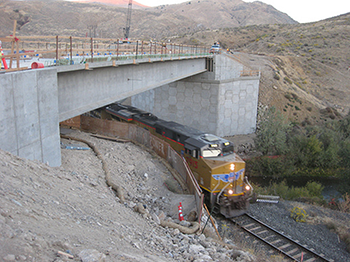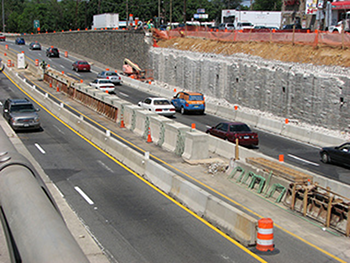
A train passes through a construction worksite within the right-of-way. (Courtesy of FHWA)
The Moving Ahead for Progress in the 21st Century Act (MAP-21) required the Federal Highway Administration (FHWA) and Federal Transit Administration (FTA) to amend their joint procedures to streamline compliance with the National Environmental Policy Act (NEPA) by designating two types of actions as categorical exclusions (CEs): (1) Any project (as defined in 23 U.S.C. 101(a)) within an existing operational right-of-way; and (2) any project that receives limited Federal funding. Accordingly, on January 13, 2014, FHWA and FTA completed a rulemaking process by publishing in the Federal Register a joint final rule that created two new CEs for the agencies. The rule, which was codified in 23 Code of Federal Regulations (CFR) Part 771 and 49 CFR Part 622, took effect on February 12, 2014.
Background on CEs
Defined in the Council on Environmental Quality’s regulations at 40 CFR 1508.4, CEs are a category of actions that do not individually or cumulatively have a significant effect on the human environment and which have been found to have no such effect in procedures adopted by a Federal agency. Based on this definition and past experience, FHWA and FTA established the new CEs for actions in the operational right-of-way or below certain limits of Federal financial involvement because these types of actions are unlikely to involve significant environmental impacts. As CEs, these types of projects are excluded from the requirements to prepare an Environmental Assessment (EA) or an Environmental Impact Statement (EIS). It is important to note that regardless of the applicability of a CE under NEPA, other applicable environmental requirements must be met.
The two new CEs have been included in FHWA’s and FTA’s environmental regulations and are now part of 23 CFR 771.117(c) and 23 CFR 771.118(c), respectively. Sections 771.117(c) and 771.118(c) contain specific lists of categories of actions, sometimes referred to as the “C-List,” that meet the regulatory requirements for CEs and normally do not require any further NEPA approvals by FHWA or FTA. Examples of existing C-List CEs include developing rest areas in an existing right-of-way, constructing bicycle or pedestrian lanes, installing noise barriers, and acquiring scenic easements.
Typically, CEs that fall under 771.117(c) or 771.118(c) involve minimal documentation and, since they are not reviewed on a case-by-case basis, there is limited reporting or tracking of the individual projects. However, in the case of the new CEs, section 1323 of MAP-21 requires that a report on the “types and justification” of actions applying these two CEs be prepared by the Secretary of Transportation and submitted to Congress within two years of MAP-21’s effective date. For this reason, FHWA and FTA are planning to collect information from the field about how these CEs are being applied. FHWA is preparing a guide to assist State Departments of Transportation (DOTs) and FHWA Divisions with gathering and submitting pertinent information.
New CE for Projects in an Existing Operational Right-of-way
The new rule creates 23 CFR 771.117(c)(22) and 771.118(c)(12), which add projects that are confined to the existing operational right-of-way as actions that meet the criteria for CEs. The existing operational right-of-way is defined by features typically associated with a transportation facility’s footprint, including the roadway itself, bridges, interchanges, and fixed guideways. The existing operational right-of-way also includes clear zones, traffic control signage, rest areas with direct access to the highway, transit power substations, and transit maintenance facilities.
A project is considered in the existing operational right-of-way if it meets all of the following criteria:
- The project is in a right-of-way that has been disturbed or transformed for an existing transportation facility; and
- The portion of the right-of-way that the project affects is maintained for transportation purposes.

Drivers navigate construction along a service road. (Courtesy of FHWA)
New CE for Projects Receiving Limited Federal Funding
The new rule also creates 23 CFR 771.117(c)(23) and 771.118(c)(13), which add projects that receive limited Federal funding as actions that meet the criteria for CEs. Limited funding is defined as any project that (A) receives less than $5,000,000 in Federal funds or (B) has a total estimated cost of less than $30,000,000, with Federal funds comprising less than 15 percent of the total estimated cost of the project. FHWA and FTA used these thresholds in the final rule because they were explicitly stated in the law.
Once underway, projects that rise above the prescribed thresholds and still need an FHWA and/or FTA action to be taken will trigger a reevaluation of the CE—a process that is consistent with other CEs. If the project does not qualify for this CE (the only CE specifically linked to funding), it may still qualify for another CE depending on the type of project.
New CEs Do Not Apply in Unusual Circumstances
During the public comment period for this rule, which closed on April 29, 2013, FHWA and FTA received comments from 40 stakeholders, including 12 State DOTs and entities, 10 transportation interest groups, 4 transit agencies, and 2 individuals.
In response to several comments, FHWA and FTA noted that consideration of unusual circumstances, as discussed in 771.117(b) of FHWA’s regulations and 771.118(b) of the FTA’s regulations, still applies to all CEs, including the two new CEs. An unusual circumstance refers to an instance in which a normally excluded action may have a significant environmental effect and, therefore, requires an EA or EIS. Additionally, any actions that would create controversy based on environmental impact or significantly alter property protected by Section 4(f) of the DOT Act (23 U.S.C. 138; 49 U.S.C. 303) or Section 106 of the National Historic Preservation Act would not qualify for either of the new CEs. Projects must also continue to conform to other Federal statutes, such as the Clean Water Act, Clean Air Act, General Bridge Act of 1946, and the Endangered Species Act.
Reducing Environmental Reporting Requirements
Projects in the existing operational right-of-way or that receive limited funding usually do not require an EA or EIS. The two new CEs described here are expected to reduce NEPA documentation requirements associated with these types of projects and thus streamline the environmental process. As with any CE, practitioners should remain aware that if an agency’s proposed action is anticipated to significantly affect an environmental resource, and that proposed action will create unusual circumstances, then that action will likely require an EA or EIS.
Contact Information
Kreig Larson
Federal Highway Administration
Office of Project Development and Environmental Review
(202) 366-2056
Kreig.Larson@dot.gov
Look What’s New!
- FHWA and FTA issued joint guidance on the implementation of financial penalty provisions included as part of section 1306 in MAP-21. The financial penalty provisions establish timeframe requirements for permits, licenses, and other approval decisions triggered under any applicable Federal law for highway projects, public transportation capital projects, or multimodal projects that also require the preparation of an EIS or an EA under FHWA/FTA’s NEPA procedures. To read the guidance, click here.
- FHWA recently hosted an ESA Webtool training webinar that discussed the Webtool’s purpose, capabilities, components, and benefits. In addition to providing a general overview of how the Webtool helps to streamline the preparation of Biological Assessments, the webinar also highlighted the basic skills necessary for using the tool as well as how users can access additional information on the Section 7 consultation process.
- FHWA and the U.S. Army Corps of Engineers produced an instructional recording for transportation users on how to use the Army Corps Regulatory In lieu fee and Bank Information Tracking System (RIBITS) to find mitigation credits for transportation projects. A version of this training was presented as a webinar in December of 2013. For more information on the tool, visit the RIBITS website.
- FHWA will host a livability webinar on April 17 on Programs and Policies to Advance Livability. Presenters will discuss the evolution of Massachusetts Department of Transportation livability policies and associated implementation and the development of livability policies and initiatives in Sandpoint, Idaho, a small town in transition.
|

